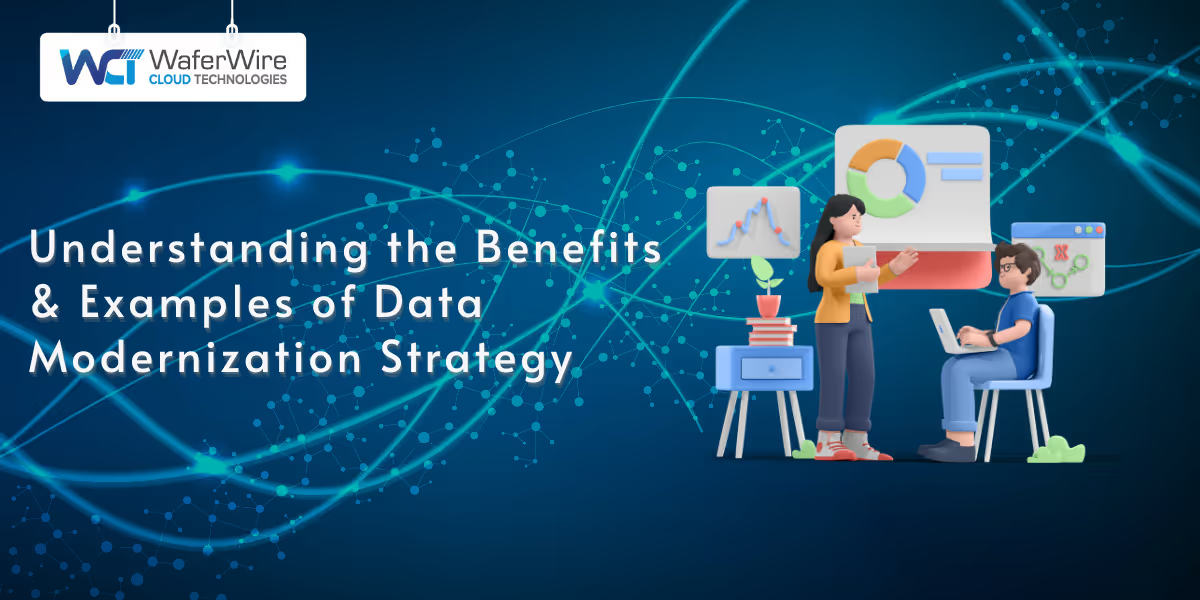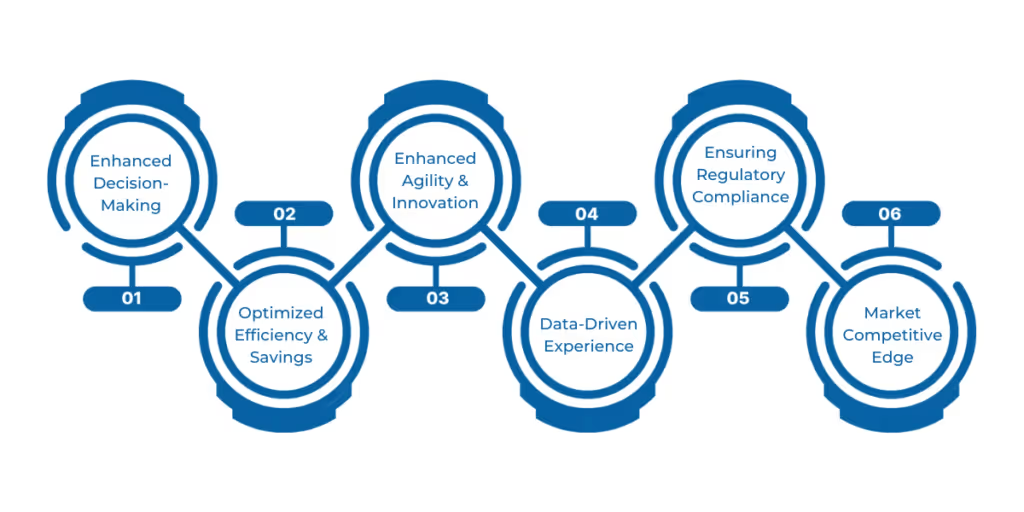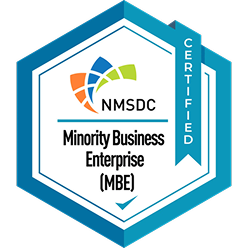

Outdated data systems are a silent threat to business growth, with 95% of companies citing the need to manage unstructured data as a key challenge. As digital transformation accelerates, traditional architectures struggle with inefficiency, security risks, and scalability issues.
A well-structured data modernization strategy addresses these concerns by shifting businesses toward agile, cloud-based solutions. From real-time analytics to AI-driven decision-making, modernization enhances operational efficiency and competitive advantage.
This blog explores the benefits of data modernization, supported by real-world examples, to illustrate how organizations can future-proof their data infrastructure while unlocking new opportunities in an increasingly data-driven world.
Data Modernization Strategy is a structured approach to transforming legacy data systems into modern, scalable, and efficient architectures that support advanced analytics, cloud computing, and real-time processing. It involves upgrading outdated databases, storage solutions, and integration frameworks to improve data accessibility, security, and performance.
According to a 2023 report by McKinsey, 80% of organizations struggle with data silos, impacting decision-making and operational efficiency. By adopting a modernization strategy, businesses ensure their data infrastructure aligns with evolving technological demands, regulatory requirements, and market dynamics. It enables them to manage and utilize data effectively in an increasingly digital landscape.
Now, let’s discuss the key benefits of data modernization strategy.

A well-executed data modernization strategy enhances efficiency, security, and scalability, enabling businesses to make data-driven decisions with greater accuracy. Below are the key benefits of modernizing data infrastructure:
Modernized data systems provide accurate, real-time insights, enabling businesses to make informed decisions. Enhanced data integration and analytics help organizations identify trends, mitigate risks, and optimize strategies for better outcomes.
Streamlined data processes reduce redundancies and manual efforts, improving overall productivity. Cloud-based storage and automation lower infrastructure costs, while optimized workflows enhance resource allocation, leading to significant cost savings.
Modern architectures allow businesses to scale operations seamlessly and adapt to evolving market needs. Agile data infrastructures support innovation, enabling companies to quickly deploy new technologies and optimize performance.
Real-time data analytics help businesses understand customer behaviors and preferences. Personalized recommendations, predictive analytics, and improved service delivery enhance customer satisfaction and engagement.
Modern data frameworks integrate security protocols and compliance measures, ensuring adherence to industry regulations. Automated monitoring and reporting reduce legal risks and safeguard sensitive information.
Businesses with modern data strategies gain an edge by responding faster to market trends. Access to real-time insights enhances strategic planning, helping companies stay ahead of competitors.
A robust data modernization strategy not only enhances business resilience but also unlocks new growth opportunities.
The following section explores the main components that define an effective modernization framework.
A successful data modernization strategy consists of key components that ensure seamless data transformation, security, and efficiency. These elements collectively enable organizations to optimize data utilization while maintaining reliability and scalability. The following are the components:
Migrating to cloud-based platforms enhances storage, processing power, and accessibility. It enables businesses to scale efficiently, reduce infrastructure costs, and improve system performance while ensuring data availability and security.
Establishing clear policies for data management ensures accuracy, consistency, and regulatory compliance. Strong governance frameworks prevent unauthorized access, reduce risks, and enhance data quality for better decision-making.
Leveraging AI and machine learning enhances predictive capabilities and automation. Modern analytics tools process vast datasets, enabling businesses to extract valuable insights and drive data-driven strategies.
Ensuring seamless data flow between various systems and applications eliminates silos and enhances collaboration. Robust integration frameworks improve efficiency by enabling real-time data access across departments.
Implementing encryption, access controls, and threat detection mechanisms strengthens data security. A proactive risk management approach minimizes breaches, protects sensitive information, and ensures business continuity.
Automating repetitive data-related tasks increases efficiency and reduces human errors. Optimized workflows enhance productivity, enabling teams to focus on high-value initiatives.
A well-defined data modernization strategy relies on these essential components for long-term success. In the next section, we will explore the critical steps involved in developing an effective modernization strategy.
A structured approach to data modernization ensures a smooth transition from legacy systems to advanced architectures. The following steps help organizations develop an effective strategy that aligns with business goals and enhances operational efficiency. Here are the steps:
Define specific business objectives to ensure data modernization aligns with long-term growth strategies. Establishing measurable goals helps organizations track progress and maximize the value derived from modernized data systems.
Conduct a comprehensive assessment of existing data storage, processing, and management systems. Identifying inefficiencies and gaps helps determine areas for improvement and ensures a well-informed modernization plan.
Recognize critical business needs, such as operational efficiency, customer experience, or compliance requirements. Prioritizing initiatives based on impact and feasibility ensures a strategic and structured modernization approach.
Choose modern tools and platforms, such as cloud computing, AI, and advanced analytics, to enhance data processing capabilities. The right technologies ensure scalability, efficiency, and future-proof data management.
Establish policies and guidelines for data quality, security, and compliance. A robust governance framework ensures consistency, accountability, and reliability in data handling.
Develop a structured migration plan to transition from legacy systems without disruptions. Ensuring seamless integration between modern and existing systems maintains operational continuity and data integrity.
Implement encryption, access controls, and risk management strategies to safeguard data. Compliance with regulatory requirements protects sensitive information and minimizes legal risks.
A well-defined roadmap ensures successful data modernization and long-term business resilience. The next section will show you some examples of organizations that have successfully implemented data modernization strategies.
Organizations worldwide are modernizing their data infrastructure to improve efficiency, scalability, and decision-making. Below are real-world examples showcasing how businesses implement data modernization strategies to stay competitive and future-proof their operations.
Many companies are shifting from on-premise data centers to cloud-based solutions like Amazon Web Services (AWS), Microsoft Azure, and Google Cloud to enhance scalability, reduce costs, and improve accessibility.
Example: Netflix successfully migrated its entire data infrastructure to AWS, enabling seamless streaming experiences for millions of users. The cloud-based platform allows Netflix to store vast amounts of content data, personalize recommendations using AI, and scale operations efficiently based on demand.
Modern organizations rely on Business Intelligence (BI) tools like Tableau, Power BI, and Google Looker to transform raw data into actionable insights, improving decision-making and operational efficiency.
Example: Walmart uses advanced analytics to track purchasing trends, predict demand, and optimize inventory across thousands of stores. Their BI-driven system ensures that the right products are available in the right locations, reducing waste and maximizing sales.
The Internet of Things (IoT) is revolutionizing industries by enabling real-time data collection and automation. Sensors and smart devices transmit data to centralized systems, providing deeper insights into operations, maintenance, and efficiency.
Example: Tesla’s vehicles continuously collect data from sensors and cameras, analyzing driving behavior, road conditions, and vehicle performance. This data helps improve Autopilot technology, predict maintenance needs, and enhance customer safety.
Artificial Intelligence (AI) and Machine Learning (ML) play a crucial role in automating business processes, optimizing workflows, and providing predictive insights. These technologies improve everything from fraud detection to customer service.
Example: JPMorgan Chase employs AI-driven automation for fraud detection, analyzing millions of transactions to identify suspicious patterns. Their machine learning models help prevent fraudulent activities, ensuring a secure banking experience for customers while reducing manual investigation efforts.
The Data-as-a-Service (DaaS) model allows organizations to provide on-demand data access across different departments or to external stakeholders, enabling seamless collaboration and reducing redundancy.
Example: Bloomberg offers real-time financial data as a service through its Bloomberg Terminal. Financial institutions, traders, and investors use this platform to access live market data, analytics, and insights, ensuring they make informed decisions based on the latest trends.
Real-world examples demonstrate how businesses across various industries leverage data modernization strategies to enhance efficiency, decision-making, and customer experiences. The next section will explore industry-specific applications of data modernization, highlighting tailored approaches in healthcare, retail, and more.
Data modernization strategies are tailored to meet the unique demands of different industries, enabling businesses and organizations to optimize operations, improve decision-making, and enhance security. Here are real-world applications of data modernization across key sectors:
Retailers use advanced data analytics, AI-driven personalization, and real-time inventory tracking to improve customer experiences. Machine learning models analyze shopping behaviors to provide personalized recommendations, optimize pricing, and enhance supply chain management.
Example: Amazon utilizes a sophisticated recommendation engine powered by AI and big data analytics. By analyzing customer browsing history, purchase behavior, and demographic data, Amazon suggests highly relevant products, increasing customer engagement and sales. Additionally, real-time data ensures optimal stock management, preventing shortages or overstocking.
Financial institutions deploy AI and machine learning algorithms to analyze vast amounts of transaction data and identify fraudulent activities. Automated systems detect anomalies in real time, preventing fraud and ensuring secure transactions.
Example: PayPal uses machine learning algorithms to analyze billions of transactions and detect fraud in real time. Their risk management system assesses various factors such as transaction frequency, location, and historical patterns to flag fraudulent transactions before they are completed. This approach significantly reduces chargebacks and enhances user trust.
Government agencies modernize data collection and analytics to track disease outbreaks, manage healthcare resources, and respond to emergencies effectively. Real-time public health data helps in early detection and prevention.
Example: The Centers for Disease Control and Prevention (CDC) employs big data analytics and AI to track the spread of infectious diseases. During the COVID-19 pandemic, the CDC used real-time data from hospitals, testing centers, and mobility reports to predict outbreak patterns and allocate vaccines efficiently, preventing further spread.
IoT sensors and AI-driven analytics help manufacturers predict equipment failures before they occur, reducing downtime and maintenance costs. These technologies enhance operational efficiency and prolong asset lifespans.
Example: General Electric (GE) integrates IoT sensors into industrial machinery to track performance metrics such as temperature, vibration, and pressure. AI analyzes this data to predict when a machine is likely to fail, allowing maintenance teams to address issues proactively. This approach has significantly reduced unexpected shutdowns and improved production efficiency.
Electronic Health Records (EHR) integration ensures seamless data sharing among healthcare providers, improving diagnosis accuracy and treatment efficiency. Advanced data analytics enable personalized care plans and better patient management.
Example: The Mayo Clinic uses an advanced EHR system to store and analyze patient data, allowing doctors to access comprehensive medical histories in real time. AI-powered analytics assist in diagnosing diseases, identifying treatment plans, and predicting patient risks, improving overall healthcare quality, and reducing medical errors.
Industry-specific data modernization strategies enable organizations to optimize processes, enhance security, and improve customer experiences. As technology evolves, businesses must continue adopting modern data frameworks to remain competitive and future-ready.
Modernizing data systems enhances decision-making, operational efficiency, and customer experiences. By adopting advanced technologies such as AI, cloud computing, and IoT, businesses gain agility and scalability, enabling them to respond swiftly to market demands.
However, modernization is an ongoing process that requires continuous evaluation, optimization, and innovation. Companies must embrace a forward-thinking approach, ensuring their data infrastructure evolves alongside technological advancements to sustain long-term growth and success in an increasingly digital economy.
Try WaferWire to empower your business with the most effective data management strategies. We align data initiatives with your business goals to maximize impact. Whether you’re starting your data journey or enhancing existing strategies, contact us today for a holistic approach with expert help!

